Annual Report 2012
Introduction
As required by section 2B of the Federal Reserve Act, the Federal Reserve Board submits written reports to the Congress that contain discussions of "the conduct of monetary policy and economic developments and prospects for the future." The Monetary Policy Report, submitted semiannually to the Senate Committee on Banking, Housing, and Urban Affairs and to the House Committee on Banking and Financial Services, is delivered concurrently with testimony from the Federal Reserve Board Chairman.
The following discussion is a review of U.S. monetary policy and economic developments in 2012, based on the Monetary Policy Reports published in February 2013 and July 2012. Those complete reports are available on the Board's website at www.federalreserve.gov/monetarypolicy/files/20130226_mprfullreport.pdf (February 2013) and www.federalreserve.gov/monetarypolicy/files/20120717_mprfullreport.pdf (July 2012).
Other materials in this annual report related to the conduct of monetary policy include the minutes of the 2012 meetings of the Federal Open Market Committee (see the Minutes section) and statistical tables 1-4 (see the Statistical Tables section).
Monetary Policy Report of February 2013
Summary
The U.S. economy continued to expand at a moderate rate, on average, over the second half of 2012. The housing recovery appeared to gain additional traction, consumer spending rose moderately, and business investment advanced further. Financial conditions eased over the period but credit remained tight for many households and businesses, and concerns about the course of federal fiscal policy and the ongoing European situation likely restrained private-sector demand. In addition, total government purchases continued to move lower in an environment of budget restraint, while export growth was held back by slow foreign economic growth. All told, real gross domestic product (GDP) is estimated to have increased at an average annual rate of 1-1/2 percent in the second half of the year, similar to the pace in the first half.
Conditions in the labor market gradually improved. Employment increased at an average monthly pace of 175,000 in the second half of the year, about the same as in the first half. The unemployment rate moved down from 8-1/4 percent last summer to a little below 8 percent in January. Even so, the unemployment rate was still well above levels observed prior to the recent recession. Moreover, it remained the case that a large share of the unemployed had been out of work for more than six months, and that a significant portion of the employed had part-time jobs because they were unable to find full-time employment. Meanwhile, consumer price inflation remained subdued amid stable long-term inflation expectations and persistent slack in labor markets. Over the second half of the year, the price index for personal consumption expenditures increased at an annual rate of 1-1/2 percent.
During the summer and fall, the Federal Open Market Committee (FOMC) judged that the economic recovery would strengthen only gradually over time, as some of the factors restraining activity--including restrictive credit for some borrowers, continuing concerns about the domestic and international economic environments, and the ongoing shift toward tighter federal fiscal policy--were thought likely to recede only slowly. Moreover, the Committee judged that the possibility of an escalation of the financial crisis in Europe and uncertainty about the course of fiscal policy in the United States posed significant downside risks to the outlook for economic activity. However, the Committee expected that, with appropriate monetary accommodation, economic growth would proceed at a moderate pace, with the unemployment rate gradually declining toward levels consistent with the FOMC's dual mandate of maximum employment and price stability. Against this backdrop, and with long-run inflation expectations well anchored, the FOMC projected that inflation would remain at or below the rate consistent with the Committee's dual mandate.
Accordingly, to promote its objectives, the FOMC provided additional monetary accommodation during the second half of 2012 by both strengthening its forward guidance regarding the federal funds rate and initiating additional asset purchases. In September, the Committee announced that it would continue its program to extend the average maturity of its Treasury holdings and would begin purchasing additional agency-guaranteed mortgage-backed securities (MBS) at a pace of $40 billion per month. The Committee also stated its intention to continue its purchases of agency MBS, undertake additional asset purchases, and employ its other policy tools as appropriate until the outlook for the labor market improves substantially in a context of price stability. The Committee agreed that in determining the size, pace, and composition of its asset purchases, it would, as always, take account of the likely efficacy and costs of such purchases. The Committee also modified its forward guidance regarding the federal funds rate at the September meeting, noting that exceptionally low levels for the federal funds rate were likely to be warranted at least through mid-2015, longer than had been indicated in previous FOMC statements. Moreover, the Committee stated its expectation that a highly accommodative stance of monetary policy would remain appropriate for a considerable time after the economic recovery strengthens.
In December, the Committee announced that in addition to continuing its purchases of agency MBS, it would purchase longer-term Treasury securities, initially at a pace of $45 billion per month, starting after the completion at the end of the year of its program to extend the maturity of its Treasury holdings. It also further modified its forward rate guidance, replacing the earlier date-based guidance with numerical thresholds for the unemployment rate and projected inflation. In particular, the Committee indicated that it expected the exceptionally low range for the federal funds rate would remain appropriate at least as long as the unemployment rate remains above 6-1/2 percent, inflation between one and two years ahead is projected to be no more than 1/2 percentage point above the Committee's 2 percent longer-run goal, and longer-term inflation expectations continue to be well anchored.
Partly in response to this additional monetary accommodation, as well as to improved sentiment regarding the situation in Europe, broad financial conditions eased over the second half of 2012. Although yields on nominal Treasury securities rose, on net, yields on inflation-protected Treasury securities declined, and longer-term interest rates paid by households and firms generally fell. Yields on agency MBS and investment- and speculative-grade corporate bonds touched record lows, and broad equity price indexes rose. Conditions in short-term dollar funding markets eased over the summer and remained stable thereafter, and market sentiment toward the banking industry improved. Nonetheless, credit remained tight for borrowers with lower credit scores, and borrowing conditions for small businesses continued to improve more gradually than for large firms.
At the time of the most recent FOMC meeting in January, Committee participants saw the economic outlook as little changed or modestly improved from the time of their December meeting, when the most recent Summary of Economic Projections (SEP) was compiled. (The December SEP is included as Part 3 of the February 2013 Monetary Policy Report; it is also included in the Minutes section of this annual report.) Participants generally judged that strains in global financial markets had eased somewhat, and that the downside risks to the economic outlook had lessened. Under the assumption of appropriate monetary policy--that is, policy consistent with the Committee's Statement on Longer-Run Goals and Monetary Policy Strategy (see box 1)--FOMC participants expected the economy to expand at a moderate pace, with the unemployment rate gradually declining and inflation remaining at or below the Committee's 2 percent longer-run goal.
Box 1. Statement on Longer-Run Goals and Monetary Policy Strategy As amended effective on January 29, 2013
The Federal Open Market Committee (FOMC) is firmly committed to fulfilling its statutory mandate from the Congress of promoting maximum employment, stable prices, and moderate long-term interest rates. The Committee seeks to explain its monetary policy decisions to the public as clearly as possible. Such clarity facilitates well-informed decisionmaking by households and businesses, reduces economic and financial uncertainty, increases the effectiveness of monetary policy, and enhances transparency and accountability, which are essential in a democratic society.
Inflation, employment, and long-term interest rates fluctuate over time in response to economic and financial disturbances. Moreover, monetary policy actions tend to influence economic activity and prices with a lag. Therefore, the Committee's policy decisions reflect its longer-run goals, its medium-term outlook, and its assessments of the balance of risks, including risks to the financial system that could impede the attainment of the Committee's goals.
The inflation rate over the longer run is primarily determined by monetary policy, and hence the Committee has the ability to specify a longer-run goal for inflation. The Committee judges that inflation at the rate of 2 percent, as measured by the annual change in the price index for personal consumption expenditures, is most consistent over the longer run with the Federal Reserve's statutory mandate. Communicating this inflation goal clearly to the public helps keep longer-term inflation expectations firmly anchored, thereby fostering price stability and moderate long-term interest rates and enhancing the Committee's ability to promote maximum employment in the face of significant economic disturbances.
The maximum level of employment is largely determined by nonmonetary factors that affect the structure and dynamics of the labor market. These factors may change over time and may not be directly measurable. Consequently, it would not be appropriate to specify a fixed goal for employment; rather, the Committee's policy decisions must be informed by assessments of the maximum level of employment, recognizing that such assessments are necessarily uncertain and subject to revision. The Committee considers a wide range of indicators in making these assessments. Information about Committee participants' estimates of the longer-run normal rates of output growth and unemployment is published four times per year in the FOMC's Summary of Economic Projections. For example, in the most recent projections, FOMC participants' estimates of the longer-run normal rate of unemployment had a central tendency of 5.2 percent to 6.0 percent, unchanged from one year ago but substantially higher than the corresponding interval several years earlier.
In setting monetary policy, the Committee seeks to mitigate deviations of inflation from its longer-run goal and deviations of employment from the Committee's assessments of its maximum level. These objectives are generally complementary. However, under circumstances in which the Committee judges that the objectives are not complementary, it follows a balanced approach in promoting them, taking into account the magnitude of the deviations and the potentially different time horizons over which employment and inflation are projected to return to levels judged consistent with its mandate.
The Committee intends to reaffirm these principles and to make adjustments as appropriate at its annual organizational meeting each January.
Return to textPart 1 Recent Economic and Financial Developments
Real gross domestic product (GDP) increased at a moderate annual rate of 1-1/2 percent, on average, in the second half of 2012--similar to the rate of increase in the first half--as various headwinds continued to restrain growth. Financial conditions eased over the second half in response to the additional monetary accommodation provided by the Federal Open Market Committee (FOMC) and to improved sentiment regarding the crisis in Europe. However, credit availability remained tight for many households and businesses. In addition, declines in real government purchases continued to weigh on economic activity, as did household and business concerns about the economic outlook, while weak foreign demand restrained exports. In this environment, conditions in the labor market continued to improve gradually but remained weak. At a little under 8 percent in January, the unemployment rate was still well above levels prevailing prior to the recent recession. Inflation remained subdued at the end of last year, with consumer prices rising at about a 1-1/2 percent annual rate in the second half, and measures of longer-run inflation expectations remained in the narrow ranges seen over the past several years.
Domestic Developments
GDP increased moderately but continued to be restrained by various headwinds
Real GDP is estimated to have increased at an annual rate of 3 percent in the third quarter but to have been essentially flat in the fourth, as economic activity was temporarily restrained by weather-related disruptions and declines in some erratic categories of spending, including inventory investment and federal defense spending.1 On average, real GDP expanded at an annual rate of 1-1/2 percent in the second half of 2012, similar to the pace of increase in the first half of the year (figure 1). The housing recovery gained additional traction, consumer spending continued to increase moderately, and business investment rose further. However, a severe drought in much of the country held down farm production, and disruptions from Hurricane Sandy also likely held back economic activity somewhat in the fourth quarter. More fundamentally, some of the same factors that restrained growth in the first half of last year likely continued to weigh on activity. Although financial conditions continued to improve overall, the financial system has not fully recovered from the financial crisis, and banks remained cautious in their lending to many households and businesses. In particular, restricted financing for home mortgages and new-home construction projects, along with the depressing effects on housing demand of an uncertain outlook for house prices and jobs, kept the level of activity in the housing sector well below longer-run norms. Budgetary pressures at all levels of government also continued to weigh on GDP growth. Moreover, businesses and households remained concerned about many aspects of the economic environment, including the uncertain course of U.S. fiscal policy at the turn of the year as well as the still-worrisome European situation and the slow recovery more generally.
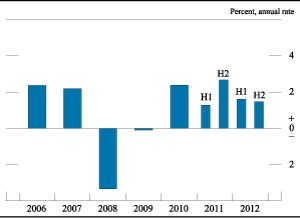
Note: Here and in subsequent figures, except as noted, change for a given period is measured to its final quarter from the final quarter of the preceding period.
Source: Department of Commerce, Bureau of Economic Analysis.
The labor market improved somewhat, but the unemployment rate remained high
In this economic environment, firms increased their workforces moderately. Over the second half of last year, nonfarm payroll employment rose an average of about 175,000 per month, similar to the average increase in the first half (figure 2). These job gains helped lower the unemployment rate from 8.2 percent in the second quarter of last year to 7.9 percent in January (figure 3). Nevertheless, the unemployment rate remained much higher than it was prior to the recent recession, and long-term unemployment continued to be widespread. In the fourth quarter, about 40 percent of the unemployed had been out of work for more than six months. Moreover, the proportion of workers employed part time because they were unable to find full-time work remained elevated. Some of the increase in the unemployment rate since the beginning of the recent recession could reflect structural changes in the labor market--such as a greater mismatch between the types of jobs that are open and the skills of workers available to fill them--that would reduce the maximum sustainable level of employment. However, most of the economic analysis on this subject suggests that the bulk of the increase in unemployment probably reflects a deficiency in labor demand.2 As a result, the unemployment rate likely remains well above levels consistent with maximum sustainable employment.
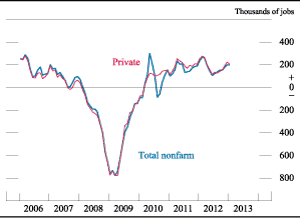
Note: The data are three-month moving averages and extend through January 2013.
Source: Department of Labor, Bureau of Labor Statistics.
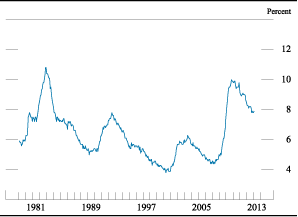
Note: The data are monthly and extend through January 2013.
Source: Department of Labor, Bureau of Labor Statistics.
As described in the box "Assessing Conditions in the Labor Market" (see box "Assessing Conditions in the Labor Market" in the February 2013 Monetary Policy Report), the unemployment rate appears to be a very good indicator of labor market conditions. That said, other indicators also provide important perspectives on the health of the labor market, and the most accurate assessment of labor market conditions can be obtained by combining the signals from many such indicators. Aside from the decline in the unemployment rate, probably the most important other pieces of evidence corroborating the gradual improvement in labor market conditions over the second half of last year were the gains in nonfarm payrolls noted earlier and the slight net reduction in initial claims for unemployment insurance.
Restrained by the ongoing weak conditions in the labor market, labor compensation has increased slowly. The employment cost index for private industry workers, which encompasses both wages and the cost to employers of providing benefits, increased only 2 percent over the 12 months of 2012, similar to the rate of gain since 2010. Similarly, nominal compensation per hour in the nonfarm business sector--a measure derived from the labor compensation data in the national income and product accounts (NIPA)--increased 2-1/2 percent over the four quarters of 2012, well below average increases of close to 4 percent in the years prior to the recent recession. As a result of these modest gains, nominal compensation has increased only about as fast as consumer prices over the recovery.
Inflation remained low . . .
Consumer price inflation was low over the second half of 2012. With considerable slack in labor markets and limited increases in labor costs, relatively stable prices for commodities and imports, and well-anchored longer-term inflation expectations, prices for personal consumption expenditures (PCE) increased at an annual rate of 1-1/2 percent in the second half of the year, similar to the rate of increase in the first half (figure 4). Excluding food and energy prices, consumer prices increased only 1 percent in the second half of the year, down from 2 percent in the first half. A deceleration in prices of imported goods likely contributed to the low rate of inflation seen in the second half, though price increases for non-energy services were also low.
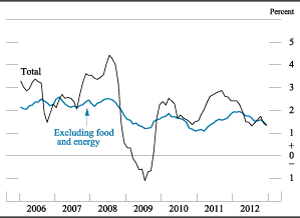
Note: The data are monthly and extend through December 2012; changes are from one year earlier.
Source: Department of Commerce, Bureau of Economic Analysis.
As noted, gains in labor compensation have been subdued given the weak conditions in labor markets, and unit labor costs--which measure the extent to which compensation rises in excess of productivity--have increased very little over the recovery. That said, compensation per hour rose more rapidly last year, and productivity growth, which has averaged 1-1/2 percent per year over the recovery, was relatively low. As a result, unit labor costs rose 2 percent in 2012, well above average increases earlier in the recovery.
Global oil prices rose in early 2012 but subsequently gave up those gains and remained about flat through the later part of the year (figure 5). Developments related to Iran, including a tightening embargo on Iranian oil exports, likely put upward pressure on prices, but these pressures were apparently offset by continued concerns about weak global demand. However, in recent weeks, global oil prices have increased in response to generally positive demand indicators from China and some reductions in Saudi production. Partly in response to this rise, retail gasoline prices, which changed little, on net, over 2012, have moved up appreciably.
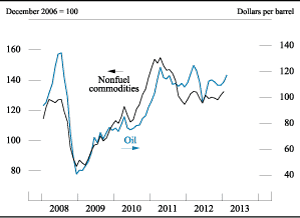
Note: The data are monthly. The oil price is the spot price of Brent crude oil, and the last observation is the average for February 1-21, 2013. The price of nonfuel commodities is an index of 45 primary-commodity prices and extends through January 2013.
Source: For oil, the Commodity Research Bureau; for nonfuel commodities, International Monetary Fund.
Nonfuel commodity prices have remained relatively flat over the past year despite significant movements in the prices of a few specific commodities. Of particular interest, prices for corn and soybeans eased some over the fall after having risen sharply during the summer as the scale of the drought affecting much of the United States became apparent. Given this easing and the small share of grain costs in the retail price of food, the effect of the drought on U.S. consumer food prices is likely to be modest: Consumer food prices rose at an annual rate of 2 percent in the fourth quarter following increases of less than 1 percent in the middle of last year.
In line with these flat overall commodity prices, as well as earlier dollar appreciation, prices for imported goods excluding oil were about unchanged on average over the last five months of 2012 and the early part of 2013.
. . . and longer-term inflation expectations stayed in their historical range
Survey measures of longer-term inflation expectations have changed little, on net, since last summer. Median expected inflation over the next 5 to 10 years, as reported in the Thomson Reuters/University of Michigan Surveys of Consumers, was 3 percent in early February, within the narrow range of the past 10 years (figure 6). In the Survey of Professional Forecasters, conducted by the Federal Reserve Bank of Philadelphia, the median expectation for the increase in the price index for PCE over the next 10 years was 2 percent in the first quarter of this year, similar to its level in recent years. A measure of 5-year inflation compensation derived from nominal and inflation-protected Treasury securities has increased 55 basis points since the end of June, while a similar measure of inflation compensation for the period 5 to 10 years ahead has increased about 30 basis points; both measures are within their respective ranges observed in the several years before the recent financial crisis (figure 7). While the increases in these measures could reflect changes in market participants' expectations of future inflation, they may also have been affected by improved investor risk sentiment and an associated reduction in demand for the relatively greater liquidity of nominal Treasury securities.
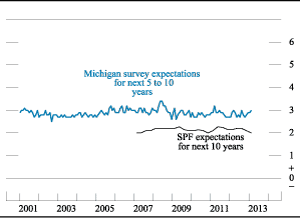
Note: The Michigan survey data are monthly and extend from January 2001 through a preliminary estimate for February 2013. The SPF data are quarterly and extend from 2007:Q1 through 2013:Q1.
Source: Thomson Reuters/University of Michigan Surveys of Consumers and Survey of Professional Forecasters (SPF).
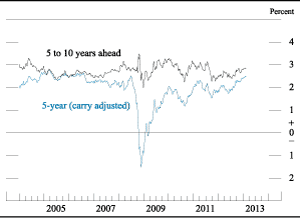
Note: The data are weekly averages of daily data and extend through February 15, 2013. Inflation compensation is the difference between yields on nominal Treasury securities and Treasury inflation-protected securities (TIPS) of comparable maturities, based on yield curves fitted to off-the-run nominal Treasury securities and on- and off-the-run TIPS. The 5-year measure is adjusted for the effect of indexation lags.
Source: Federal Reserve Bank of New York; Barclays; Federal Reserve Board staff estimates.
Consumer spending continued to increase moderately
Turning to some important components of final demand, real PCE increased at a moderate annual rate of 2 percent over the second half of 2012, similar to the rate of increase in the first half (figure 8). Household wealth--buoyed by increases in house prices and equity values--moved up over the second half of the year and provided some support for consumer spending. In addition, for those households with access to credit, low interest rates spurred spending on motor vehicles and other consumer durables, which increased at an annual rate of 11 percent over the second half of last year. But increases in real wages and salaries were modest over the second half of the year, and overall growth in consumer spending continued to be held back by concerns about the economic outlook and limited access to credit for some households. After rising earlier in the year, consumer sentiment--which reflects household views on their own financial situations as well as broader economic conditions--fell back at the end of the year and stood well below longer-run norms.
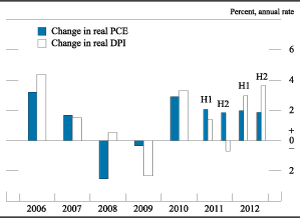
Note: The data are quarterly and extend through 2012:Q4.
Source: Department of Commerce, Bureau of Economic Analysis.
Real disposable personal income (DPI) rose at an annual rate of 3-1/2 percent over the second half of 2012. However, much of this increase was a result of unusually large increases in dividends and employee bonuses, as many firms apparently shifted income disbursements into 2012 in anticipation of an increase in marginal tax rates for high-income households at the beginning of this year. Excluding these special payments, real DPI is estimated to have increased at a modest annual rate of 1-1/4 percent over the second half of the year, similar to the average pace of increase over the recovery. The surge in dividend and bonus payments also led the personal saving rate to jump from 3.8 percent in the second quarter to 4.7 percent in the fourth quarter. In their absence, the saving rate would have likely been little changed over the second half of the year.
Households continue to pay down debt and gain access to credit
Household debt--the sum of mortgage and consumer debt--edged down further in the third quarter of 2012 as a continued contraction in mortgage debt more than offset a solid expansion in consumer credit. With the reduction in household debt, low levels of most interest rates, and modest income growth, the household debt service ratio--the ratio of required principal and interest payments on outstanding household debt to DPI--decreased further and, at the end of the third quarter, stood at a level last seen in 1983.
Consumer credit expanded at an annual rate of about 5-1/4 percent in the second half of 2012. Nonrevolving credit (mostly auto loans and student loans), which accounts for about two-thirds of total consumer credit outstanding, drove the increase. Revolving consumer credit (primarily credit card lending) was about flat on net. Overall, the increase in nonrevolving consumer credit is consistent with banks' recent responses to the Senior Loan Officer Opinion Survey on Bank Lending Practices (SLOOS), which indicated that demand had strengthened and standards eased, on net, for auto loans.3
Changes in interest rates on consumer loans were mixed over the second half of 2012. Interest rates on auto loans declined a bit, as did most measures of the spreads of rates on these loans over yields on Treasury securities of comparable maturity. Interest rates on credit card debt quoted by banks generally declined slightly, while rates observed in credit card offer mailings continued to increase.
The housing market recovery gained traction . . .
The housing market has continued to recover. Housing starts, sales of new and existing homes, and builder and realtor sentiment all increased over the second half of last year, and residential investment rose at an annual rate of nearly 15 percent. Combined, single-family and multifamily housing starts rose from an average annual rate of 740,000 in the second quarter of last year to 900,000 in the fourth quarter (figure 9). Activity increased most noticeably in the smaller multifamily sector--where starts have nearly reached pre-recession levels--as demand for new housing has apparently shifted toward smaller rental units and away from larger, typically owner-occupied single-family units.
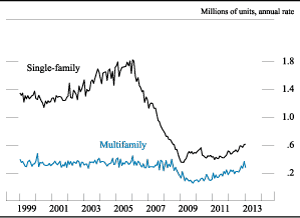
Note: The data are monthly and extend through January 2013.
Source: Department of Commerce, Bureau of the Census.
. . . as mortgage interest rates reached record lows and house prices rose . . .
Mortgage interest rates declined to historically low levels toward the end of 2012--importantly reflecting Federal Reserve policy actions--making housing quite affordable for households with good credit ratings (figure 10). However, the spread between mortgage rates and yields on agency-guaranteed mortgage-backed securities (MBS) remained elevated by historical standards. This unusually wide spread probably reflects still-elevated risk aversion and some capacity constraints among mortgage originators. Overall, refinance activity increased briskly over the second half of 2012--though it was still less than might have been expected, given the level of interest rates--while the pace of mortgage applications for home purchases remained sluggish. Recent responses to the SLOOS indicate that banks' lending standards for residential mortgage loans were little changed over the second half of 2012.
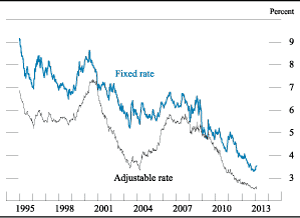
Note: The data, which are weekly and extend through February 20, 2013, are contract rates on 30-year mortgages.
Source: Federal Home Loan Mortgage Corporation.
House prices, as measured by several national indexes, continued to increase in the second half of 2012. For example, the CoreLogic repeat-sales index rose 3-1/2 percent (not an annual rate) over the last six months of the year to reach its highest level since late 2008 (figure 11). This recent improvement notwithstanding, this measure of house prices remained 27 percent below its peak in early 2006.
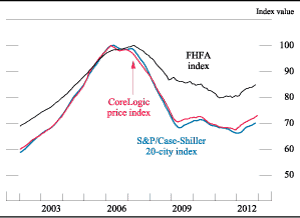
Note: The data are monthly and extend into 2012:Q4. Each index has been normalized so that its peak is 100. Both the CoreLogic price index and the FHFA index include purchase transactions only. The S&P/Case-Shiller index reflects all arm's-length sales transactions in selected metropolitan areas.
Source: For CoreLogic, CoreLogic; for FHFA, Federal Housing Finance Agency; for S&P/Case-Shiller, Standard & Poor's.
. . . but the level of new construction remained low, and mortgage delinquencies remained elevated
Despite the improvements seen over the second half of 2012, housing starts remained well below the 1960-2000 average of 1.5 million per year, as concerns about the job market and tight mortgage credit for less-credit-worthy households continued to restrain demand for housing. In addition, although the number of vacant homes for sale has declined significantly, the stock of vacant homes held off the market remained quite elevated. Once put on the market, this "shadow" inventory, which likely includes many bank-owned properties, may redirect some demand away from new homes and toward attractively priced existing homes. With home values depressed and unemployment still high, measures of late-stage mortgage delinquency, such as the inventory of properties in foreclosure, remained elevated, keeping high the risk of homes transitioning to vacant bank-owned properties.
Growth of business investment has slowed since earlier in the recovery
After increasing at double-digit rates in 2010 and 2011, business expenditures on equipment and software (E&S) decelerated in 2012 (figure 12). Pent-up demand for capital goods, an important contributor to earlier increases in E&S spending, has likely diminished as the recovery has aged. In addition, concerns about possible threats to economic growth and stability from U.S. fiscal policy and the situation in Europe may have contributed to soft investment spending in the middle of last year. As a result, despite a pickup in the pace of gains toward the end of the year, E&S investment increased at an annual rate of 5 percent in the second half of the year, similar to the first-half pace. As for business investment in structures, a sustained recovery has yet to take hold, as high vacancy rates, tight credit for new construction, and low prices for commercial real estate (CRE) are still hampering investment in new buildings. However, in the drilling and mining sector, elevated oil prices and new drilling technologies have kept investment in structures at a relatively high level.
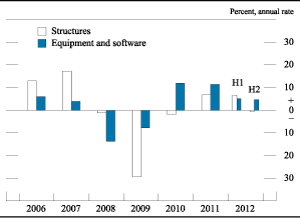
Inventory investment remained at a moderate level in the second half of last year, as limited growth in final sales and the uncertain economic environment continued to limit firms' incentives to accumulate inventories. Census Bureau measures of book-value inventory-to-sales ratios, as well as surveys of private inventory satisfaction and plans, generally suggest that stocks were fairly well aligned with sales at the end of 2012.
Corporate earnings growth slowed, but firms' balance sheets remained strong
After having risen 6 percent over the first half of 2012, aggregate operating earnings per share for S&P 500 firms were about flat on a seasonally adjusted basis in the second half of 2012, held down, in part, by weak demand from Europe and some emerging market economies (EMEs). However, the ratio of corporate profits to gross national product in the second half of 2012 hovered around its historical high, and cash flow remained solid. In addition, the ratio of liquid assets to total assets for nonfinancial corporations was close to its highest level in more than 20 years, and the aggregate debt-to-asset ratio remained low by historical standards.
With corporate credit quality remaining robust and interest rates at historically low levels, nonfinancial firms continued to raise funds at a strong pace in the second half of 2012. Bond issuance by both investment- and speculative-grade nonfinancial firms was extraordinarily strong, although much of the proceeds from bond issuance appeared to be earmarked for the refinancing of existing debt. Meanwhile, nonfinancial commercial paper (CP) outstanding was about unchanged. Issuance in the institutional segment of the syndicated leveraged loan market accelerated in the second half of the year, boosted by rapid growth of newly established collateralized loan obligations. Commercial and industrial (C&I) loans outstanding at commercial banking organizations in the United States continued to expand at a brisk pace in the second half of 2012. Moreover, according to the SLOOS, modest net fractions of banks continued to report having eased their lending standards on C&I loans over the second half of the year, and large net fractions of banks indicated having reduced the spread of rates on C&I loans over their cost of funds, largely in response to increased competition from other banks or nonbank lenders.
Gross public equity issuance by nonfinancial firms slowed a bit in the second half of 2012, held down by a moderate pace of initial public offerings. Meanwhile, data for the third quarter of 2012 indicate that net equity issuance remained deeply negative, as share repurchases and cash-financed mergers by nonfinancial firms remained robust.
Borrowing conditions for small businesses continued to improve, albeit more gradually than for large firms
Borrowing conditions for small businesses continued to improve over the second half of 2012, but as has been the case in recent years, the improvement was more gradual than for larger firms. Moreover, the demand for credit from small firms apparently remained subdued. C&I loans with original amounts of $1 million or less--a large share of which likely consist of loans to small businesses--rose slightly in the second half of 2012, at about the same rate that prevailed in the first half. Recent readings from the Survey of Terms of Business Lending indicate that the spreads charged by commercial banks on newly originated C&I loans with original amounts less than $1 million, while still quite elevated, continued to decline.4
According to surveys conducted by the National Federation of Independent Business during the second half of 2012, the fraction of small businesses with borrowing needs stayed low. The net percentage of respondents that found credit more difficult to obtain than three months prior edged up, on balance, over this period, as did the net percentage that expected tighter credit conditions over the next three months; both measures remained at relatively high levels in the January survey.
Financial conditions in the commercial real estate sector eased but remained relatively tight
Financial conditions in the CRE sector continued to ease but remained relatively tight amid weak fundamentals. According to the SLOOS, a modest net fraction of banks reported having eased standards on CRE loans over the second half of last year, and a significant net fraction of banks reported increased demand for such loans. Consistent with these readings, the multiyear contraction in banks' holdings of CRE loans continued to slow and, indeed, came roughly to a halt as banks' holdings of CRE loans were about flat over the last quarter of 2012. Issuance of commercial mortgage-backed securities (CMBS) continued to increase over the second half of 2012 from the low levels observed in 2011. Nonetheless, the delinquency rate on loans in CMBS pools remained extremely high, as some borrowers with five-year loans issued in 2007 were unable to refinance upon the maturity of those loans because of high loan-to-value ratios. While delinquency rates for CRE loans at commercial banks continued to decline, they remained somewhat elevated, especially for construction and land development loans.
Budget strains for state and local governments eased, but federal purchases continued to decline
Strains on state and local government budgets appear to have lessened some since earlier in the recovery. Although federal grants provided to state governments in the American Recovery and Reinvestment Act have essentially phased out, state and local tax receipts, which have been increasing since 2010, rose moderately further over the second half of last year. Accordingly, after declining at an annual rate of 1-1/2 percent in the first half of last year, real government purchases at the state and local level changed little in the second half (figure 13). Similarly, employment levels at states and municipalities, which had been declining since 2009, changed little, on balance, over the second half of last year.
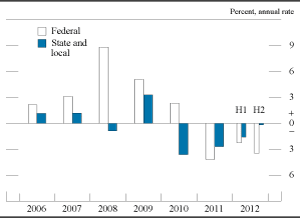
Federal purchases continued to decline over the second half of 2012, reflecting ongoing efforts to reduce the budget deficit and the scaling back of overseas military activities. As measured in the NIPA, real federal expenditures on consumption and gross investment--the part of federal spending included in the calculation of GDP--fell at an annual rate of 3-1/2 percent over the second half of 2012. Real defense spending fell at an annual rate of a little over 6 percent, while nondefense purchases increased at an annual rate of 2 percent.
The deficit in the federal unified budget remains high. The budget deficit for fiscal year 2012 was $1.1 trillion, or 7 percent of nominal GDP, down from the deficit recorded in 2011 but still sharply higher than the deficits recorded prior to the onset of the last recession. The narrowing of the budget deficit relative to fiscal 2011 reflected an increase in tax revenues that largely stemmed from the gradual increase in economic activity as well as a decline in spending. Despite the rise in tax revenues, the ratio of federal receipts to national income, at 16 percent in fiscal 2012, remained near the low end of the range for this ratio over the past 60 years. The ratio of federal outlays to GDP declined but was still high by historical standards, at 23 percent. With deficits still large, federal debt held by the public rose to 73 percent of nominal GDP in the fourth quarter of 2012, 5 percentage points higher than at the end of 2011.
Net exports added modestly to real GDP growth
Real imports of goods and services contracted at an annual rate of nearly 2 percent over the second half of 2012, held back by the sluggish pace of U.S. demand (figure 14). The decline in imports was fairly broad based across major trading partners and categories of trade.
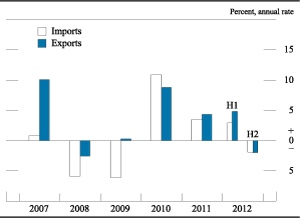
Real exports of goods and services also fell at an annual rate of about 2 percent in the second half despite continued expansion in demand from EMEs. Exports were dragged down by a steep falloff in demand from the euro area and declining export sales to Japan, consistent with weak economic conditions in those areas. In contrast, exports to Canada remained essentially flat. Across the major categories of exports, industrial supplies, automotive products, and agricultural goods contributed to the overall decrease.
Overall, real net exports added an estimated 0.1 percentage point to real GDP growth in the second half of 2012, according to the advance estimate of GDP from the Bureau of Economic Analysis, but data received since then suggest a somewhat larger positive contribution.
The nominal trade deficit shrank, on net, over the second half of 2012, contributing to the narrowing of the current account deficit to 2-3/4 percent of GDP in the third quarter. The trade deficit as a share of GDP narrowed substantially in late 2008 and early 2009 when U.S. imports dropped sharply, in part reflecting the steep decline in oil prices. Since then, the trade deficit as a share of GDP has remained close to its 2009 level: Although imports recovered from their earlier drop, exports strengthened as well.
The current account deficit in the third quarter was financed by strong inflows from foreign official institutions and by foreign private purchases of Treasury securities and equities. More-recent data suggest continued strong foreign purchases of Treasury securities and equities in the fourth quarter of 2012. Consistent with improved market sentiment over the third quarter, U.S. investors also increased their holdings of foreign assets.
National saving is very low
Total U.S. net national saving--that is, the saving of U.S. households, businesses, and governments, net of depreciation charges--remains extremely low by historical standards. In the third quarter of last year, net national saving as a percent of nominal GDP was close to zero. The relative flatness of the national saving rate over the past few years reflects the offsetting effects of a narrowing in the federal budget deficit as a share of nominal GDP and a downward movement in the private saving rate. National saving will likely remain low this year, in light of the still-large federal budget deficit. A portion of the decline in federal savings relative to pre-recession levels is cyclical and would be expected to reverse as the economy recovers. If low levels of national saving persist over the longer run, they will likely be associated with both low rates of capital formation and heavy borrowing from abroad, limiting the rise in the standard of living for U.S. residents over time.
Financial Developments
Expectations regarding the future stance of monetary policy reflected the additional accommodation provided by the Federal Open Market Committee . . .
In response to the steps taken by the FOMC to provide additional monetary policy accommodation over the second half of 2012, market participants pushed out the date when they expect the federal funds rate to first rise above its current target range of 0 to 1/4 percent. In particular, interest rates on overnight index swaps indicate that investors currently anticipate that the effective federal funds rate will rise above its current target range around the fourth quarter of 2014, roughly four quarters later than they expected at the end of June 2012. Meanwhile, the modal target rate path--the most likely values for future federal funds rates derived from interest rate options--suggests that investors think the rate is most likely to remain in its current range through the first quarter of 2016. In addition, recent readings from the Survey of Primary Dealers conducted by the Open Market Desk at the Federal Reserve Bank of New York suggest that market participants expect the Federal Reserve to hold about $3.75 trillion of Treasury and agency securities at the end of 2014, roughly $1 trillion more than was expected in the middle of 2012.5
. . . and held yields on longer-term Treasury securities and agency mortgage-backed securities near historic lows
Yields on nominal and inflation-protected Treasury securities remained near historic lows over the second half of 2012 and into 2013. Yields on longer-term nominal Treasury securities rose, on balance, over this period, while yields on inflation-protected securities fell (figure 15). These changes likely reflect the effects of additional monetary accommodation, a substantial improvement in sentiment regarding the crisis in Europe that reduced demand for the relative safety and liquidity of nominal Treasury securities, and increases in the prices of key commodities since the end of June 2012. On balance, yields on 5-, 10-, and 30-year nominal Treasury securities increased roughly 15 basis points, 30 basis points, and 40 basis points, respectively, from their levels at the end of June 2012, while yields on 5- and 10-year inflation-protected securities decreased roughly 55 basis points and 15 basis points, respectively. Treasury auctions generally continued to be well received by investors, and the Desk's outright purchases and sales of Treasury securities did not appear to have a material adverse effect on liquidity or market functioning.
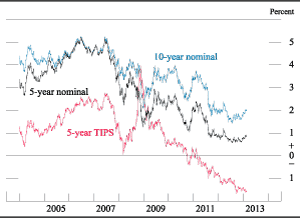
Note: The data are daily and extend through February 21, 2013. Treasury inflation-protected securities (TIPS) are based on yield curves fitted by Federal Reserve staff to on- and off-the-run TIPS.
Source: Department of the Treasury; Barclays; Federal Reserve Board staff estimates.
Yields on agency MBS were little changed, on net, over the second half of 2012 and into 2013. They fell sharply following the FOMC's announcement of additional agency MBS purchases in September but retraced over subsequent months. Spreads of yields on agency MBS over yields on nominal Treasury securities narrowed, largely reflecting the effects of the additional monetary accommodation. The Desk's outright purchases of agency MBS did not appear to have a material adverse effect on liquidity or market functioning, although implied financing rates for some securities in the MBS dollar roll market declined in the second half of 2012, and the Desk responded by postponing settlement of some purchases using dollar roll transactions.6
Yields on corporate bonds reached record lows, and equity prices increased
Yields on investment- and speculative-grade bonds reached record lows in the second half of 2012 and early 2013, respectively, partly reflecting the effects of the FOMC's additional monetary policy accommodation and increased investor appetite for bearing risk. Spreads to comparable-maturity Treasury securities also narrowed substantially but remained above the narrowest levels that they reached prior to the financial crisis (figure 16). Prices in the secondary market for syndicated leveraged loans have increased, on balance, since the middle of 2012.
Figure 16. Spreads of corporate bond yields over comparable off-the-run Treasury yields, by securities rating, 1997-2013
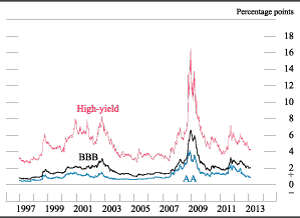
Note: The data are daily and extend through February 21, 2013. The spreads shown are the yields on 10-year bonds less the 10-year Treasury yield.
Source: Derived from smoothed corporate yield curves using Merrill Lynch bond data.
Broad equity price indexes have increased about 10 percent since the end of June 2012, boosted by the same factors that contributed to the narrowing in bond spreads. Nevertheless, the spread between the 12-month forward earnings-price ratio for the S&P 500 and a long-run real Treasury yield--a rough gauge of the equity risk premium--remained at the high end of its historical range. Implied volatility for the S&P 500 index, as calculated from option prices, spiked at times but is currently near the bottom end of the range it has occupied since the onset of the financial crisis.
Conditions in short-term dollar funding markets improved some in the third quarter and remained stable thereafter
Measures of stress in unsecured dollar funding markets eased somewhat in the third quarter of 2012 and remained stable at relatively low levels thereafter, reflecting improved sentiment regarding the crisis in Europe. For example, the average maturity of unsecured financial CP issued by institutions with European parents increased, on net, to around the same length as such CP issued by institutions with U.S. parents.
Signs of stress were largely absent in secured short-term dollar funding markets. In the market for repurchase agreements (repos), bid-asked spreads and haircuts for most collateral types have changed little since the middle of 2012. However, repo rates continued to edge up over the second half of 2012, likely reflecting in part the financing of the increase in dealers' inventories of shorter-term Treasury securities that resulted from the maturity extension program (MEP). Following year-end, repo rates fell back as the MEP came to an end and the level of reserve balances began to increase. In asset-backed commercial paper (ABCP) markets, volumes outstanding declined a bit for programs with European and U.S. sponsors, while spreads on ABCP with European bank sponsors remained slightly above those on ABCP with U.S. bank sponsors.
Year-end pressures in short-term funding markets were generally modest and roughly in line with the experiences during other years since the financial crisis.
Market sentiment toward the banking industry improved as the profitability of banks increased
Market sentiment toward the banking industry improved in the second half of 2012, reportedly driven in large part by perceptions of reduced downside risks stemming from the European crisis. Equity prices for bank holding companies (BHCs) increased, outpacing the increases in broad equity price indexes, and BHC credit default swap (CDS) spreads declined (figure 17).
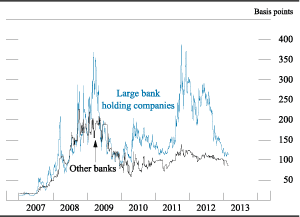
Note: The data are daily and extend through February 21, 2013. Median spreads for six large bank holding companies and nine other banks.
Source: Markit.
The profitability of BHCs increased in the second half of 2012 but continued to run well below the levels that prevailed before the financial crisis. Measures of asset quality generally improved further, as delinquency and charge-off rates decreased for almost all major loan categories, although the recent improvement in delinquency rates for consumer credit in part reflects a compositional shift of credit supply toward higher-credit-quality borrowers. Loan loss provisions were flat at around the slightly elevated levels seen prior to the crisis, though they continued to be outpaced by charge-offs. Regulatory capital ratios remained at high levels based on current standards, but the implementation of generally more stringent Basel III capital requirements will likely lead to some decline in reported regulatory capital ratios at the largest banks. Overall, banks remain well funded with deposits, and their reliance on short-term wholesale funding stayed near its low levels seen in recent quarters. The expiration of the Federal Deposit Insurance Corporation's Transaction Account Guarantee program on December 31, 2012, does not appear to have caused any significant change in the availability of deposit funding for banks.
Credit provided by commercial banking organizations in the United States increased in the second half of 2012 at about the same moderate pace as in the first half of the year. Core loans--the sum of C&I loans, real estate loans, and consumer loans--expanded modestly, with strong growth in C&I loans offsetting weakness in real estate and credit card loans. Banks' holdings of securities continued to rise moderately overall, as strong growth in holdings of Treasury and municipal securities more than offset modest declines in holdings of agency MBS.
Despite continued improvements in market conditions, risks to the stability of financial markets remain
While conditions in short-term dollar funding markets have improved, these markets remain vulnerable to potential stresses. Money market funds (MMFs) have sharply reduced their overall exposures to Europe since the middle of 2011, but prime fund exposures to Europe continue to be substantial. MMFs also remain susceptible to the risk of investor runs due to structural vulnerabilities posed by the rounding of net asset values and the absence of loss-absorbing capital.7
Dealer firms have reduced their wholesale short-term funding ratios and have increased their liquidity buffers in recent years, but they still heavily rely on wholesale short-term funding. As a result, they remain susceptible to swings in market confidence and a possible resurgence of anxiety regarding counterparty credit risk. Respondents to the Senior Credit Officer Opinion Survey on Dealer Financing Terms indicated that credit terms applicable to important classes of counterparties were little changed over the second half of 2012.8 Dealers reported increased demand for funding of securitized products and indicated that the use of financial leverage among trading real estate investment trusts, or REITs, had increased somewhat. However, respondents continued to note an increase in the amount of resources and attention devoted to the management of concentrated exposures to central counterparties and other financial utilities as well as, to a smaller extent, dealers and other financial intermediaries.
With prospective returns on safe assets remaining low, some financial market participants appeared willing to take on more duration and credit risk to boost returns. The pace of speculative-grade corporate bond issuance has been rapid in recent months, and while most of this issuance appears to have been earmarked for the refinancing of existing debt, there has also been an increase in debt to facilitate transactions involving significant risks. In particular, in bonds issued to finance private equity transactions, there has been a reemergence of payment-in-kind options that permit the issuer to increase the face value of debt in lieu of a cash interest payment, and anecdotal reports indicate that bond covenants are becoming less restrictive. Similarly, issuance of bank loans to finance dividend recapitalization deals as well as covenant-lite loans was robust over the second half of the year. (For a discussion of regulatory steps taken related to financial stability, see the box "The Federal Reserve's Actions to Foster Financial Stability" in the February 2013 Monetary Policy Report.)
Federal Reserve assets increased, and the average maturity of its Treasury holdings lengthened . . .
Total assets of the Federal Reserve increased to $3,097 billion as of February 20, 2013, $231 billion more than at the end of June 2012 (table 1). The increase primarily reflects growth in Federal Reserve holdings of Treasury securities and agency MBS as a result of the purchase programs initiated at the September 2012 and December 2012 FOMC meetings. As of February 20, 2013, the par value of Treasury securities and agency MBS held by the Federal Reserve had increased $70 billion and $178 billion, respectively, since the end of June 2012. The composition of Treasury securities holdings also changed over the second half of 2012 as a result of the continuation of the MEP, which was announced at the June 2012 FOMC meeting. Under this program, between July and December, the Desk purchased $267 billion in Treasury securities with remaining maturities of 6 to 30 years and sold or redeemed an equal par value of Treasury securities with maturities of 3 years or less. As a result, the average maturity of the Federal Reserve's Treasury holdings increased 1.7 years over the second half of 2012 and into 2013 and, as of February 2013, stood at 10.5 years.
| Balance sheet item | Feb. 22, 2012 | June 27, 2012 | Feb. 20, 2013 |
|---|---|---|---|
| Total assets | 2,935,149 | 2,865,698 | 3,096,802 |
| Selected assets | |||
| Credit extended to depository institutions and dealers | |||
| Primary credit | 3 | 18 | 8 |
| Central bank liquidity swaps | 107,959 | 27,059 | 5,192 |
| Credit extended to other market participants | |||
| Term Asset-Backed Securities Loan Facility (TALF) | 7,629 | 4,773 | 439 |
| Net portfolio holdings of TALF LLC | 825 | 845 | 507 |
| Support of critical institutions | |||
| Net portfolio holdings of Maiden Lane LLC, Maiden Lane II LLC, and Maiden Lane III LLC 1 | 30,822 | 15,031 | 1,483 |
| Securities held outright | |||
| U.S. Treasury securities | 1,656,581 | 1,666,530 | 1,736,456 |
| Agency debt securities | 100,817 | 91,484 | 74,613 |
| Agency mortgage-backed securities (MBS) 2 | 853,045 | 854,979 | 1,032,712 |
| Total liabilities | 2,880,556 | 2,811,029 | 3,041,820 |
| Selected liabilities | |||
| Federal Reserve notes in circulation | 1,048,004 | 1,067,917 | 1,127,723 |
| Reverse repurchase agreements | 89,824 | 83,737 | 93,121 |
| Deposits held by depository institutions | 1,622,800 | 1,491,988 | 1,668,383 |
| Of which: Term deposits | 0 | 0 | 0 |
| U.S. Treasury, general account | 36,033 | 117,923 | 40,703 |
| U.S. Treasury, Supplementary Financing Account | 0 | 0 | 0 |
| Total capital | 54,594 | 54,669 | 54,982 |
Note: LLC is a limited liability company.
1. The Federal Reserve has extended credit to several LLCs in conjunction with efforts to support critical institutions. Maiden Lane LLC was formed to acquire certain assets of The Bear Stearns Companies, Inc. Maiden Lane II LLC was formed to purchase residential mortgage-backed securities from the U.S. securities lending reinvestment portfolio of subsidiaries of American International Group, Inc. (AIG). Maiden Lane III LLC was formed to purchase multisector collateralized debt obligations on which the Financial Products group of AIG has written credit default swap contracts. Return to table
2. Includes only MBS purchases that have already settled. Return to table
Source: Federal Reserve Board, Statistical Release H.4.1, "Factors Affecting Reserve Balances of Depository Institutions and Condition Statement of Federal Reserve Banks."
. . . while exposure to facilities established during the crisis continued to wind down
In the second half of 2012, the Federal Reserve continued to reduce its exposure to facilities established during the financial crisis to support specific institutions. The portfolio holdings of Maiden Lane LLC and Maiden Lane III LLC--entities that were created during the crisis to acquire certain assets from The Bear Stearns Companies, Inc., and American International Group, Inc., to avoid the disorderly failures of those institutions--declined $14 billion to approximately $1 billion, primarily reflecting the sale of the remaining securities in Maiden Lane III LLC that was announced in August 2012. These sales resulted in a net gain of $6.6 billion for the benefit of the U.S. public. The Federal Reserve's loans to Maiden Lane LLC and Maiden Lane III LLC had been fully repaid, with interest, as of June 2012. Loans outstanding under the Term Asset-Backed Securities Loan Facility (TALF) decreased $4 billion to under $1 billion because of prepayments and maturities of TALF loans. With accumulated fees collected through TALF exceeding the amount of TALF loans outstanding, the Federal Reserve and the Treasury agreed in January to end the backstop for TALF provided by the Troubled Asset Relief Program.
The improvement in offshore U.S. dollar funding markets over the second half of 2012 led to a decline in the outstanding amount of dollars provided through the temporary U.S. dollar liquidity swap arrangements with other central banks. As of February 20, 2013, draws on the liquidity swap lines were $5 billion, down from $27 billion at the end of June 2012. On December 13, 2012, the Federal Reserve announced the extension of these arrangements through February 1, 2014.
On the liability side of the Federal Reserve's balance sheet, deposits held by depository institutions increased $176 billion since June 2012, while Federal Reserve notes in circulation rose $60 billion, reflecting solid demand both at home and abroad. M2 has increased at an annual rate of about 8 percent since June 2012. Holdings of M2 assets, including its largest component, liquid deposits, remain elevated relative to what would have been expected based on historical relationships with nominal income and interest rates, likely due to investors' continued preference to hold safe and liquid assets.
As part of its ongoing program to ensure the readiness of tools to manage reserves, the Federal Reserve conducted a series of small-value reverse repurchase transactions using all eligible collateral types with its expanded list of counterparties, as well as a few small-value repurchase agreements with primary dealers. In the same vein, the Federal Reserve continued to offer small-value term deposits through the Term Deposit Facility to provide eligible institutions with an opportunity to become familiar with term deposit operations.
International Developments
Foreign financial market stresses abated . . .
Since mid-July, global financial market conditions have improved, on balance, in part reflecting reduced fears of a significant worsening of the European fiscal and financial crisis. Market sentiment was bolstered by a new European Central Bank (ECB) framework for purchases of sovereign debt known as Outright Monetary Transactions (OMT), agreements on continued official-sector support for Greece, progress by Spain in recapitalizing its troubled banks, and some steps toward fiscal and financial integration in Europe. Nevertheless, financial market stresses in Europe remained elevated, and policymakers still face significant challenges (see the box "An Update on the European Fiscal and Banking Crisis" in the February 2013 Monetary Policy Report).
Reduced concerns about the European crisis contributed to an easing of funding conditions for European banks. Euro-area banks have relied somewhat less on ECB funding in recent months, and use of central bank dollar liquidity swap lines declined significantly. Reflecting market views of the decreased risk of default, CDS premiums on the debt of many large banks in Europe dropped significantly, on net, especially for Italy and Spain, and euro-area bank stocks increased about 30 percent since mid-2012.
As risk sentiment improved, foreign equity indexes rose significantly: Over the second half of 2012 and into early 2013, equity indexes increased about 10 percent for the United Kingdom and Canada, about 15 percent in the euro area, and about 25 percent in Japan; equity indexes in EMEs also moved up across the board. Likewise, yields on 10-year government bonds in many countries increased moderately, though Japanese yields remained below 1 percent. Spreads of peripheral European sovereign yields over German bond yields of comparable maturity declined significantly as overall euro-area financial strains abated (figure 18). Corporate credit spreads also declined, and bond issuance picked up.
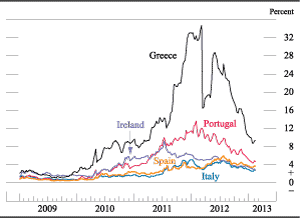
Note: The data are weekly. The last observation for each series is February 15, 2013. The spreads shown are the yields on 10-year bonds less the 10-year German bond yield.
Source: For Greece, Italy, Portugal, and Spain, Bloomberg; for Ireland, staff estimates using traded bond prices from Thomson Reuters and Bloomberg.
The U.S. dollar depreciated nearly 1 percent against a broad set of currencies over the second half of 2012 and into early 2013 (figure 19). Some of this depreciation reflected a reversal of flight-to-safety flows, in part stemming from the reduction in European financial stress. Indeed, the dollar depreciated 4 percent against the euro. In contrast, the dollar appreciated 17 percent against the Japanese yen. Most of this rise came in recent months, as Shinzo Abe, the newly elected prime minister of Japan, called for the Bank of Japan to employ "unlimited easing" of monetary policy to overcome deflation.
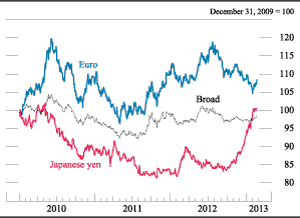
Note: The data, which are in foreign currency units per dollar, are daily. The last observation for each series is February 21, 2013.
Source: Federal Reserve Board, Statistical Release H.10, "Foreign Exchange Rates."
. . . but economic activity in the advanced foreign economies continued to weaken . . .
Despite the easing of financial stresses in the euro area and some improvement in global financial markets, activity in the advanced foreign economies (AFEs) continued to lose steam in the second half of 2012. The euro area fell further into recession, as fiscal austerity, rising unemployment, and depressed confidence restrained spending, especially in the countries at the center of the crisis. Real GDP also contracted in Japan, reflecting plummeting exports. In the United Kingdom, real GDP growth resumed in the third quarter, partly thanks to a temporary boost to demand from the London Olympics, but contracted again in the fourth quarter. Canadian real GDP growth remained positive but also weakened, largely owing to lower external demand. Survey indicators suggest that conditions in the AFEs improved only marginally around the turn of the year. Amid this weakness in economic activity and limited pressures from commodity prices, inflation readings for most AFEs remained contained.
Several foreign central banks expanded their balance sheets further and took other actions to support their economies. In addition to its introduction of the OMT, the ECB lowered its main policy rate. The Bank of England completed its latest round of asset purchases, bringing its holdings to £375 billion, and began the implementation of its Funding for Lending Scheme, designed to boost lending to households and firms. The Bank of Japan took a number of steps. It introduced a new Stimulating Bank Lending Facility in October and raised its inflation target from 1 percent to 2 percent in January. In addition, it increased the size of its Asset Purchase Program by ¥30 trillion, to ¥101 trillion, by the end of 2013 and announced that purchases would be open ended beginning in 2014.
. . . even as economic growth stabilized in emerging market economies
After slowing earlier in the year, in part because of headwinds associated with Europe's troubles, economic growth in EMEs stabilized in the third quarter and appeared to pick up in the fourth. This modest pickup in economic activity in the face of continued weakness in exports to advanced economies was supported by monetary and fiscal policy stimulus.
In China, following slower growth in the first half of 2012, stimulus measures helped boost the pace of real GDP growth in the second half of the year. Improved economic conditions in China also provided a lift to other emerging Asian economies. GDP accelerated in Hong Kong and Taiwan in the third quarter; in the fourth quarter, exports and purchasing managers indexes moved higher in most of the region, and GDP growth rebounded in a number of economies.
After stagnating for about a year, economic activity in Brazil picked up in the third quarter to a still-lackluster pace of 2-1/2 percent. Indicators for the fourth quarter suggest a further modest pickup, supported by accommodative policies. In contrast, GDP growth in Mexico continued to fall in the third quarter as the growth of U.S. manufacturing production slowed; however, Mexican growth picked up to 3 percent in the fourth quarter, boosted by services and the volatile agricultural sector.
Despite occasional spikes in food prices, inflation in most emerging Asian economies remained well contained as moderate output growth limited broader price pressures. India was a notable exception, with 12-month inflation around 10 percent in recent months. In some Latin American economies, increases in food prices had a greater effect on inflation than in Asia, leading to 12-month price increases of around 5-1/2 percent in Brazil and around 4-1/4 percent in Mexico over the second half of last year.
Part 2 Monetary Policy
To promote the objectives given to it by the Congress, the Federal Open Market Committee (FOMC) provided additional monetary accommodation at its September 2012 and December 2012 meetings, by both strengthening its forward guidance regarding the federal funds rate and initiating additional asset purchases.
As discussed in Part 1, incoming economic data throughout the second half of 2012 and into 2013 indicated that economic activity was expanding at a moderate pace. Employment gains were modest, and although the unemployment rate declined somewhat over the period, it remained elevated relative to levels that almost all members of the FOMC viewed as consistent with the Committee's dual mandate. Inflation remained subdued, apart from some temporary variations that largely reflected fluctuations in commodities prices. Members generally attached an unusually high level of uncertainty to their assessments of the economic outlook. Moreover, they continued to judge that the risks to economic growth were tilted to the downside because of strains in financial markets stemming from the sovereign debt and banking situation in Europe, as well as the potential for a significant slowdown in global economic growth and for a sharper-than-anticipated fiscal contraction in the United States. With longer-term inflation expectations stable and still-considerable slack in resource markets, most members anticipated that inflation over the medium term would run at or below the Committee's longer-run goal of 2 percent.
Accordingly, to promote the FOMC's objectives of maximum employment and price stability, the Committee maintained a target range for the federal funds rate of 0 to 1/4 percent throughout the second half of 2012 and provided additional monetary accommodation at its September and December meetings, by both strengthening its forward guidance regarding the federal funds rate and initiating additional purchases of longer-term securities. The Committee also completed at year-end the continuation of the program to extend the average maturity of its holdings of Treasury securities that was announced in June 2012 and continued its policy of reinvesting principal payments from its holdings of agency debt and agency-guaranteed mortgage-backed securities (MBS) into agency MBS.
At the September 12-13 meeting, the Committee agreed that the outlook called for additional monetary accommodation, and that such accommodation should be provided by both strengthening its forward guidance regarding the federal funds rate and initiating additional purchases of agency MBS at a pace of $40 billion per month. Along with the ongoing purchases of $45 billion per month of longer-term Treasury securities under the maturity extension program announced in June, these purchases increased the Committee's holdings of longer-term securities by about $85 billion each month through the end of the year. These actions were taken to put downward pressure on longer-term interest rates, support mortgage markets, and help make broader financial conditions more accommodative (see box 2, "Efficacy and Costs of Large-Scale Asset Purchases"). The Committee agreed that it would closely monitor incoming information on economic and financial developments in coming months, and that if the outlook for the labor market did not improve substantially, it would continue its purchases of agency MBS, undertake additional asset purchases, and employ its other policy tools as appropriate until such improvement is achieved in a context of price stability. The Committee also agreed that in determining the size, pace, and composition of its asset purchases, it would, as always, take appropriate account of the likely efficacy and costs of such purchases. This flexible approach was seen as allowing the Committee to tailor its policy over time in response to incoming information while clarifying its intention to improve labor market conditions, thereby enhancing the effectiveness of the action by helping to bolster business and consumer confidence.
The Committee also modified its forward guidance regarding the federal funds rate at the September meeting, noting that exceptionally low levels for the federal funds rate were likely to be warranted at least through mid-2015, longer than had been indicated in previous FOMC statements. Moreover, the Committee stated its expectation that a highly accommodative stance of monetary policy would remain appropriate for a considerable time after the economic recovery strengthens. The new language was meant to clarify that the Committee's anticipation that exceptionally low levels for the federal funds rate were likely to be warranted at least through mid-2015 did not reflect an expectation that the economy would remain weak, but rather reflected the Committee's determination to support a stronger economic recovery.
At the December 11-12 meeting, members judged that continued provision of monetary accommodation was warranted in order to support further progress toward the Committee's goals of maximum employment and price stability. The Committee judged that, following the completion of the maturity extension program at the end of the year, such accommodation should be provided in part by continuing to purchase agency MBS at a pace of $40 billion per month and by purchasing longer-term Treasury securities at a pace initially set at $45 billion per month. The Committee also decided that, starting in January, it would resume rolling over maturing Treasury securities at auction.
With regard to its forward rate guidance, the Committee decided to indicate in the statement that it expects the highly accommodative stance of monetary policy to remain appropriate for a considerable time after the asset purchase program ends and the economic recovery strengthens. In addition, it replaced the date-based guidance for the federal funds rate with numerical thresholds linked to the unemployment rate and projected inflation. In particular, the Committee indicated that it expected that the exceptionally low range for the federal funds rate would be appropriate at least as long as the unemployment rate remains above 6-1/2 percent, inflation between one and two years ahead is projected to be no more than 1/2 percentage point above the Committee's 2 percent longer-run goal, and longer-term inflation expectations continue to be well anchored. These thresholds were seen as helping the public to more readily understand how the likely timing of an eventual increase in the federal funds rate would shift in response to unanticipated changes in economic conditions and the outlook. Accordingly, thresholds could increase the probability that market reactions to economic developments would move longer-term interest rates in a manner consistent with the Committee's assessment of the likely future path of short-term interest rates. The Committee indicated in its December statement that it viewed the economic thresholds, at least initially, as consistent with its earlier, date-based guidance. The new language noted that the Committee would also consider other information when determining how long to maintain the highly accommodative stance of monetary policy, including additional measures of labor market conditions, indicators of inflation pressures and inflation expectations, and readings on financial developments.
At the conclusion of its January 29-30 meeting, the Committee made no changes to its target range for the federal funds rate, its asset purchase program, or its forward guidance for the federal funds rate. The Committee stated that, with appropriate policy accommodation, it expected that economic growth would proceed at a moderate pace and the unemployment rate would gradually decline toward levels the Committee judges consistent with its dual mandate. It noted that strains in global financial markets had eased somewhat, but that it continued to see downside risks to the economic outlook. The Committee continued to anticipate that inflation over the medium term likely would run at or below its 2 percent objective.
Box 2. Efficacy and Costs of Large-Scale Asset Purchases
In order to provide additional monetary stimulus when short-term interest rates are near zero, the Federal Reserve has undertaken a series of large-scale asset purchase (LSAP) programs. Between late 2008 and early 2010, the Federal Reserve purchased approximately $1.7 trillion in longer-term Treasury securities, agency debt, and agency mortgage-backed securities (MBS). From late 2010 to mid-2011, a second round of LSAPs was implemented, consisting of purchases of $600 billion in longer-term Treasury securities. Between September 2011 and the end of 2012, the Federal Reserve implemented the maturity extension program and its continuation, under which it purchased approximately $700 billion in longer-term Treasury securities and sold or allowed to run off an equal amount of shorter-term Treasury securities. And in September and December 2012, the Federal Reserve announced flow-based purchases of agency MBS and longer-term Treasury securities at initial paces of $40 billion and $45 billion per month, respectively.
These purchases were undertaken in order to put downward pressure on longer-term interest rates, support mortgage markets, and help to make broader financial conditions more accommodative, thereby supporting the economic recovery. One mechanism through which asset purchases can affect financial conditions is the "portfolio balance channel," which is based on the premise that different financial assets may be reasonably close but imperfect substitutes in investors' portfolios. This assumption implies that changes in the supplies of various assets available to private investors may affect the prices or yields of those assets and the prices of assets that may be reasonably close substitutes. As a result, the Federal Reserve's asset purchases can push up the prices and lower the yields on the securities purchased and influence other asset prices as well. As investors further rebalance their portfolios, overall financial conditions should ease more generally, stimulating economic activity through channels similar to those for conventional monetary policy. In addition, asset purchases could also signal that the central bank intends to pursue a more accommodative policy stance than previously thought, thereby lowering investor expectations about the future path of the federal funds rate and putting additional downward pressure on longer-term yields.
A substantial body of empirical research finds that the Federal Reserve's asset purchase programs have significantly lowered longer-term Treasury yields.1 More important, the effects of LSAPs do not seem to be restricted to Treasury yields. In particular, LSAPs have been found to be associated with significant declines in MBS yields and corporate bond yields as well as with increases in equity prices.
While there seems to be substantial evidence that LSAPs have lowered longer-term yields and eased broader financial conditions, obtaining accurate estimates of the effects of LSAPs on the macroeconomy is inherently difficult, as the counterfactual case--how the economy would have performed without LSAPs--cannot be directly observed. However, econometric models can be used to estimate the effects of LSAPs on the economy under the assumption that the economic effects of the easier financial conditions that are induced by LSAPs are similar to those that are induced by conventional monetary policy easing. Model simulations conducted at the Federal Reserve have generally found that asset purchases provide a significant boost to the economy. For example, a study based on the Federal Reserve Board's FRB/US model estimated that, as of 2012, the first two rounds of LSAPs had raised real gross domestic product almost 3 percent and increased private payroll employment by about 3 million jobs, while lowering the unemployment rate about 1.5 percentage points, relative to what would have been expected otherwise. These simulations also suggest that the program materially reduced the risk of deflation.2
Of course, all model-based estimates of the macroeconomic effects of LSAPs are subject to considerable statistical and modeling uncertainty and thus should be treated with caution. Indeed, while some other studies also report significant macroeconomic effects from asset purchases, other research finds smaller effects.3 Nonetheless, a balanced reading of the evidence supports the conclusion that LSAPs have provided meaningful support to the economic recovery while mitigating deflationary risks.
The potential benefits of LSAPs must be considered alongside their possible costs. One potential cost of conducting additional LSAPs is that the operations could lead to a deterioration in market functioning or liquidity in markets where the Federal Reserve is engaged in purchasing. More specifically, if the Federal Reserve becomes too dominant a buyer in a certain market, trading among private participants could decrease enough that market liquidity and price discovery become impaired. As the global financial system relies on deep and liquid markets for U.S. Treasury securities, significant impairment of this market would be especially costly; impairment of this market could also impede the transmission of monetary policy. Although the large volume of the Federal Reserve's purchases relative to the size of the markets for Treasury or agency securities could ultimately become an issue, few if any problems have been observed in those markets thus far.
A second potential cost of LSAPs is that they may undermine public confidence in the Federal Reserve's ability to exit smoothly from its accommodative policies at the appropriate time. Such a reduction in confidence might increase the risk that long-term inflation expectations become unanchored. The Federal Reserve is certainly aware of these concerns and accordingly has placed great emphasis on developing the necessary tools to ensure that policy accommodation can be removed when appropriate. For example, the Federal Reserve will be able to put upward pressure on short-term interest rates at the appropriate time by raising the interest rate it pays on reserves, using draining tools like reverse repurchase agreements or term deposits with depository institutions, or selling securities from the Federal Reserve's portfolio. To date, the expansion of the balance sheet does not appear to have materially affected long-term inflation expectations.
A third cost to be weighed is that of risks to financial stability. For example, some observers have raised concerns that, by driving longer-term yields lower, nontraditional policies could induce imprudent risk-taking by some investors. Of course, some risk-taking is a necessary element of a healthy economic recovery, and accommodative monetary policies could even serve to reduce the risk in the system by strengthening the overall economy. Nonetheless, the Federal Reserve has substantially expanded its monitoring of the financial system and modified its supervisory approach to take a more systemic perspective.
There has been limited evidence so far of excessive buildups of duration, credit risk, or leverage, but the Federal Reserve will continue both its careful oversight and its implementation of financial regulatory reforms designed to reduce systemic risk.4
The Federal Reserve has remitted substantial income to the Treasury from its earnings on securities, totaling some $290 billion since 2009. However, if the economy continues to strengthen and policy accommodation is withdrawn, remittances will likely decline in coming years. Indeed, in some scenarios, particularly if interest rates were to rise quickly, remittances to the Treasury could be quite low for a time.5 Even in such scenarios, however, average annual remittances over the period affected by the Federal Reserve's purchases are highly likely to be greater than the pre-crisis norm, perhaps substantially so. Moreover, if monetary policy promotes a stronger recovery, the associated reduction in the federal deficit would far exceed any variation in the Federal Reserve's remittances to the Treasury. That said, the Federal Reserve conducts monetary policy to meet its congressionally mandated objectives of maximum employment and price stability and not primarily for the purpose of turning a profit for the U.S. Department of the Treasury.
1. For a selective list of references regarding the effect of the first LSAP, see the box "The Effects of Federal Reserve Asset Purchases" in Board of Governors of the Federal Reserve System (2011), Monetary Policy Report to the Congress (Washington: Board of Governors, March), www.federalreserve.gov/monetarypolicy/mpr_20110301_part2.htm. For additional references, including those that analyze the effect of the second LSAP as well as the maturity extension program, see, for example, Stefania D'Amico, William English, David López-Salido, and Edward Nelson (2012), "The Federal Reserve's Large-Scale Asset Purchase Programmes: Rationale and Effects," Economic Journal, vol. 122 (November), pp. F415-45; Arvind Krishnamurthy and Annette Vissing-Jorgensen (2011), "The Effects of Quantitative Easing on Interest Rates: Channels and Implications for Policy," Brookings Papers on Economic Activity, Fall, pp. 215-65; Canlin Li and Min Wei (2012), "Term Structure Modelling with Supply Factors and the Federal Reserve's Large Scale Asset Purchase Programs," Finance and Economics Discussion Series 2012-37 (Washington: Board of Governors of the Federal Reserve System, May), www.federalreserve.gov/pubs/feds/2012/201237/201237pap.pdf, and references in those studies. For work that specifically emphasizes the signaling channel of LSAPs, see, for example, Michael D. Bauer and Glenn D. Rudebusch (2012), "The Signaling Channel for Federal Reserve Bond Purchases," Working Paper Series 2011-21 (San Francisco: Federal Reserve Bank of San Francisco, August), www.frbsf.org/publications/economics/papers/2011/wp11-21bk.pdf ![]() . For work that focuses on the effects on credit default risk, see, for example, Simon Gilchrist and Egon ZakrajÅ¡ek (2012), "The Impact of the Federal Reserve's Large-Scale Asset Purchase Programs on Default Risk," paper presented at "Macroeconomics and Financial Intermediation: Directions since the Crisis," a conference held at the National Bank of Belgium, Brussels, December 9-10, 2011. Although the majority of research on the effects of LSAPs appears to support a significant influence on asset prices, the overall result of such programs is generally difficult to estimate precisely: Event studies can make only sharp predictions on the effects within a relatively short time horizon, whereas approaches based on time-series models tend to face challenges in isolating the effects of the programs from other economic developments. For a more skeptical view on the effect of LSAPs, see, for example, Daniel L. Thornton (2012), "Evidence on the Portfolio Balance Channel of Quantitative Easing," Working Paper Series 2012-015A (St. Louis: Federal Reserve Bank of St. Louis, October), http://research.stlouisfed.org/wp/2012/2012-015.pdf
. For work that focuses on the effects on credit default risk, see, for example, Simon Gilchrist and Egon Zakrajšek (2012), "The Impact of the Federal Reserve's Large-Scale Asset Purchase Programs on Default Risk," paper presented at "Macroeconomics and Financial Intermediation: Directions since the Crisis," a conference held at the National Bank of Belgium, Brussels, December 9-10, 2011. Although the majority of research on the effects of LSAPs appears to support a significant influence on asset prices, the overall result of such programs is generally difficult to estimate precisely: Event studies can make only sharp predictions on the effects within a relatively short time horizon, whereas approaches based on time-series models tend to face challenges in isolating the effects of the programs from other economic developments. For a more skeptical view on the effect of LSAPs, see, for example, Daniel L. Thornton (2012), "Evidence on the Portfolio Balance Channel of Quantitative Easing," Working Paper Series 2012-015A (St. Louis: Federal Reserve Bank of St. Louis, October), http://research.stlouisfed.org/wp/2012/2012-015.pdf ![]() . Return to text
. Return to text
2. These results are discussed further in Hess Chung, Jean-Philippe Laforte, David Reifschneider, and John C. Williams (2012), "Have We Underestimated the Likelihood and Severity of Zero Lower Bound Events?" Journal of Money, Credit and Banking, vol. 44 (February supplement), pp. 47-82. Return to text
3. For studies reporting significant macroeconomic effects from asset purchases, see, for example, Jeffrey C. Fuhrer and Giovanni P. Olivei (2011), "The Estimated Macroeconomic Effects of the Federal Reserve's Large-Scale Treasury Purchase Program," Public Policy Briefs 11-02 (Boston: Federal Reserve Bank of Boston, April), www.bos.frb.org/economic/ppb/2011/ppb112.pdf ![]() ; and Christiane Baumeister and Luca Benati (2012), "Unconventional Monetary Policy and the Great Recession: Estimating the Macroeconomic Effects of a Spread Compression at the Zero Lower Bound," Working Papers 2012-21 (Ottawa: Bank of Canada, July), www.bankofcanada.ca/wp-content/uploads/2012/07/wp2012-21.pdf
; and Christiane Baumeister and Luca Benati (2012), "Unconventional Monetary Policy and the Great Recession: Estimating the Macroeconomic Effects of a Spread Compression at the Zero Lower Bound," Working Papers 2012-21 (Ottawa: Bank of Canada, July), www.bankofcanada.ca/wp-content/uploads/2012/07/wp2012-21.pdf ![]() . Also, the Bank of England has implemented LSAPs similar to those undertaken by the Federal Reserve, and its staff research finds that the effects appear to be quantitatively similar to those in the United States.
. Also, the Bank of England has implemented LSAPs similar to those undertaken by the Federal Reserve, and its staff research finds that the effects appear to be quantitatively similar to those in the United States.
For studies reporting smaller effects from asset purchases, see, for example, Michael T. Kiley (2012), "The Aggregate Demand Effects of Short- and Long-Term Interest Rates," Finance and Economics Discussion Series 2012-54 (Washington: Board of Governors of the Federal Reserve System, August), www.federalreserve.gov/pubs/feds/2012/201254/201254pap.pdf; and Han Chen, Vasco Curdia, and Andrea Ferrero (2012), "The Macroeconomic Effects of Large-Scale Asset Purchase Programmes," Economic Journal, vol. 122 (November), pp. F289-315. Return to text
4. For additional details, see the box "The Federal Reserve's Actions to Foster Financial Stability" in the February 2013 Monetary Policy Report. Return to text
5. For additional details, see Seth B. Carpenter, Jane E. Ihrig, Elizabeth C. Klee, Daniel W. Quinn, and Alexander H. Boote (2013), "The Federal Reserve's Balance Sheet and Earnings: A primer and projections," Finance and Economics Discussion Series 2013-01 (Washington: Board of Governors of the Federal Reserve System, January), www.federalreserve.gov/pubs/feds/2013/201301/201301abs.html. Return to text
Return to textReferences
1. Data for the fourth quarter of 2012 from the national income and product accounts reflect the advance estimate released on January 30, 2013. Return to text
2. See, for example, Mary C. Daly, Bart Hobijn, Ayşegűl Şahin, and Robert G. Valletta (2012), "A Search and Matching Approach to Labor Markets: Did the Natural Rate of Unemployment Rise?" Journal of Economic Perspectives, vol. 26 (Summer), pp. 3-26; Michael W. L. Elsby, Bart Hobijn, Ayşegűl Şahin, and Robert G. Valletta (2011), "The Labor Market in the Great Recession--An Update to September 2011," Brookings Papers on Economic Activity, Fall, pp. 353-71; and Jesse Rothstein (2012), "The Labor Market Four Years into the Crisis: Assessing Structural Explanations," ILRReview, vol. 65 (July), pp. 467-500. Return to text
3. The SLOOS is available on the Federal Reserve Board's website at www.federalreserve.gov/boarddocs/SnLoanSurvey. Return to text
4. Data releases for the Survey of Terms of Business Lending are available on the Federal Reserve Board's website at www.federalreserve.gov/releases/e2/default.htm. Return to text
5. The Survey of Primary Dealers is available on the Federal Reserve Bank of New York's website at www.newyorkfed.org/markets/primarydealer_survey_questions.html ![]() . Return to text
. Return to text
6. Dollar roll transactions consist of a purchase or sale of agency MBS with the simultaneous agreement to sell or purchase substantially similar securities on a specified future date. The Committee directs the Desk to engage in these transactions as necessary to facilitate settlement of the Federal Reserve's agency MBS purchases. Return to text
7. In November 2012, the Financial Stability Oversight Council proposed recommendations for structural reforms of U.S. MMFs to reduce their vulnerability to runs and mitigate associated risks to the financial system. Return to text
8. The Senior Credit Officer Opinion Survey on Dealer Financing Terms is available on the Federal Reserve Board's website at www.federalreserve.gov/econresdata/releases/scoos.htm. Return to text
